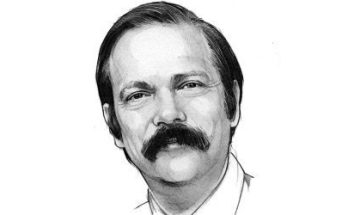“The Lithium Mine Versus the Wildflower”
WIRED, June 17, 2021
Backchannel
By Gregory Barber
“The deposit could power millions of clean-energy car batteries. There’s just one roadblock: a rare, fragile species of buckwheat, for which a mine might mean extinction.”
Whatever act of violence occurred in the midsummer heat on that lonely white hill in Nevada, there was no one around to see it. By the time Naomi Fraga arrived there in mid-September, the air had cooled and investigators had already visited the scene. But the evidence of a selective massacre remained: Where there had once been plants, there were now hundreds of empty holes. A few mangled stems, severed from their roots, lay half buried in the chalky dirt. What alarmed Fraga more than the dead or missing was the selective way they had been targeted. The white hill stood atop a high desert ridge that was once part of an ancient caldera, and it was home to a wide variety of Great Basin flora. There were various species, including saltbushes and sagebrush. But only one appeared to have fallen victim to the unseen attack—a buckwheat. As she walked around the scene, Fraga’s first reaction was disbelief. What, or who, had it out for this particular plant?
The stricken species was named Eriogonum tiehmii, or Tiehm’s wild buckwheat. (Tiehm is pronounced like “team.”) Fraga had first met the plant in late spring, when the rains coax out a single pale yellow puffball of a blossom. Fraga thought it was adorable. It would make a splendid addition to a garden in Whoville. But the bloom lasts only a month. Most of the year the plant lies dormant; its plump leaves dry out and fade to a charmless gray.
Fraga is a botanist who considers herself to be in the service of plants. Many people love plants. They will tenderly care for them, encourage flowering or fruit, take an interest in the bark and leaves on a trail. A scientist may devote a lifetime to studying a single species. But to Fraga, these acts of appreciation, while welcome, are rooted in selfishness, not service. In her work as conservation director at the California Botanic Garden, near Los Angeles, she is frequently asked why a person should care about a rare plant. Sometimes she poses this question to herself, like a catechism. Fraga doesn’t mean to get “all woo-woo” on you, but here it is: Her answer is not rooted in beauty or usefulness or even a sense of curiosity or wonder, but because a species exists uniquely on this earth. Fraga knows that most people don’t feel this way. It is a level of respect that plants do not often receive.
What called her to the service of the Tiehm’s buckwheat was its rarity. Fraga often hikes to the top of the white hill, where she can look out over the complete universe of the plant. At the time of her initial visit, the latest count was 44,000 buckwheats across 10 acres, rooted in eight patches of white earth. Some time ago—perhaps thousands of years, or maybe tens of thousands, nobody can say—seeds found their way into this soil, which lacks important nutrients like phosphorus and nitrogen, and is extremely alkaline, more like baking soda than loam. But wild buckwheats, which are relatively distant cousins of the crop used to make flour for pancakes, are a tenacious genus of plant, known for making do with whatever soil they happen upon. Evolution ran its course, and a new species emerged. The plant learned to grow there and, as far as anyone knew, only there. There were no competitors for that toxic soil. Until, that is, the lithium mine.
In mining terms, the alkaline soil is called overburden—material that’s stripped away to access desired material below. The value of lithium has soared recently as the reality of climate change hits home. The element is at the heart of the batteries that will power millions of electric cars and a renewable energy grid. In April, President Biden set a goal of halving US emissions from 2005 levels by 2030, and global demand for lithium-ion batteries is expected to quintuple by then. Until now, lithium has come almost exclusively from overseas, but as the rest of the world makes a similar scramble for resources, this supply is growing increasingly precarious. The mine that was proposed for this Nevada spot, known as Rhyolite Ridge, wouldn’t solve that shortage on its own, but it would make a dent The area has enough battery-grade material to power about 400,000 electric cars a year for at least a quarter century. The total value of the mine’s resources was estimated at $10 billion.
Even an amateur geologist viewing the landscape could see how hopelessly the habitat and the resource are intertwined. The white patches in which the buckwheat grow are outcrops of a rock called searlesite, where much of the lithium is locked. The mine would swallow much of the buckwheat’s habitat—60 percent of the plants would be removed in phase one of the project, rising to 90 percent during phase two, according to conservationists. To compensate, the mine owners, who deny the loss would be that high, planned to transplant the buckwheat or grow it from seed in unoccupied soil nearby. But for a plant that has not naturally colonized any other home, it is not clear if they would survive the move.
No one doubts the value of lithium to mitigate climate change. But there would be costs wherever the element was extracted from the ground, and here that cost would come at the expense of a plant. Fraga had decided the buckwheat was hers to protect. That September day, she couldn’t make sense of what she saw. She knew the summer had been unusually dry, which meant that animals were seeking moisture wherever they could, perhaps in the roots of plants. Maybe they had caused the destruction. But her first thought was that it had something to do with the mine. All she knew for certain was that, while she was away, nearly half of an entire species had been destroyed. Fraga looked out over the hill. She wondered if she had already failed this plant.
Lithium is a feisty element. When it’s bonded with other elements to form a compound colloquially known as a salt, it may act as a mood stabilizer. But on its own it’s erratic, always wanting to give up an electron and take on a charge. It must remain under seal; the briefest contact with water or humid air will cause it to combust in a popping, sparking flame. These qualities also make it a perfect material for batteries, which are about taming the ephemeral—a spark, a flame—and bottling it up for later. Inside a battery, lithium ions and their liberated electrons will happily shuttle through an electrolyte from one end, the anode, to the other, the cathode, generating power along the way. And because lithium is the lightest metallic element, relatively little mass is required to store a lot of juice. In a Tesla Model S, only 3 percent of the battery pack is lithium metal, according to some outside estimates.
That level of efficiency, though, was long in coming. The first rechargeable battery, invented in 1859 by Gaston Plante, involved lead and acid. The same basic chemistry still creates the spark that starts a gas-powered car engine, but the design is as heavy and toxic as it sounds, and not powerful enough for many modern uses. By the beginning of the last century, scientists believed that lithium-based designs could pack more punch, going longer without weighing things down. It would take decades of experiments to work out the chemistry, and a viable commercial model emerged only in the 1990s. Three scientists who made it possible were awarded the Nobel Prize in 2019.
It is a miraculous thing that in 2021 a car can drive from Los Angeles to San Francisco on a single electric charge and without spewing exhaust, or that a solar farm can compete with a gas plant by storing electrons overnight. The rising demand for new electric cars and trucks is expected to lead to a tripling of the energy capacity of new batteries between 2020 and 2025. These batteries aren’t perfect. They will need to get smaller, more recyclable, more powerful, and also more diversified, with versions that depend on other resources, such as sodium or manganese. In the interim, though, the world needs a lot more lithium.
About the Author:
Gregory Barber is a staff writer at WIRED who writes about blockchain, AI, and tech policy. He graduated from Columbia University with a bachelor’s degree in computer science and English literature and now lives in San Francisco.






